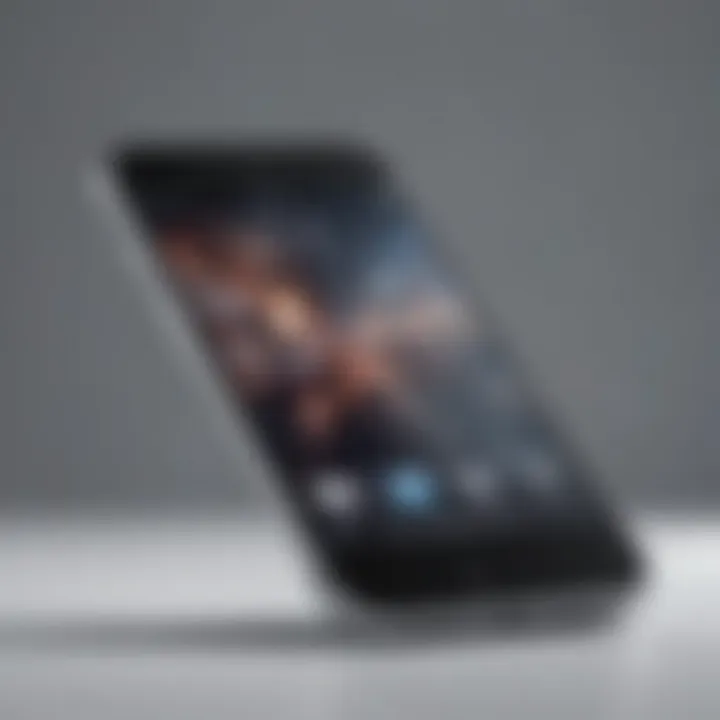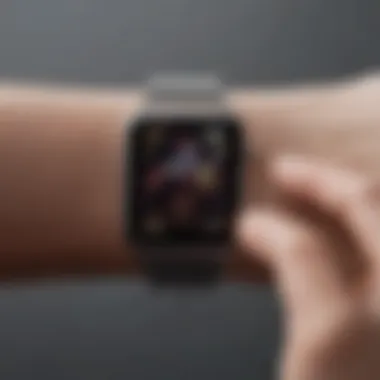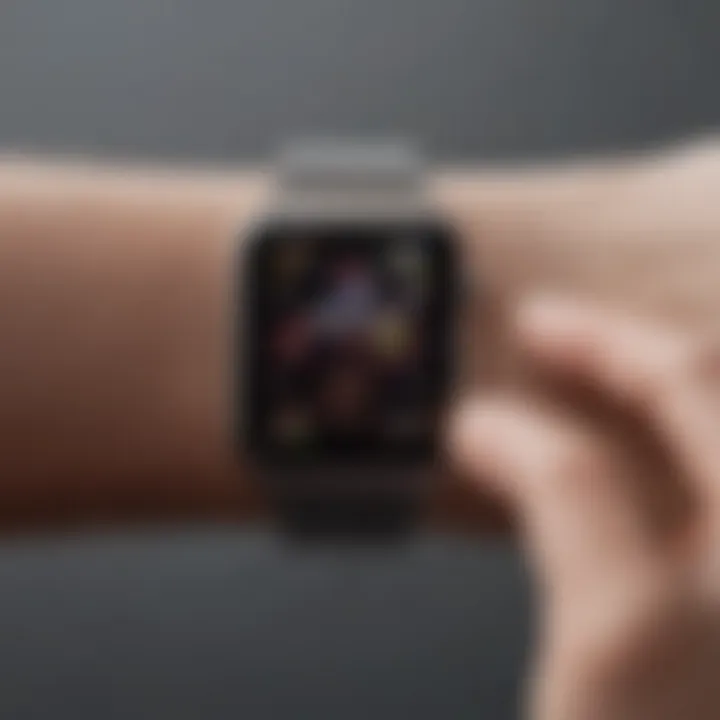Discovering Apple Products: Features and Impact


Intro
In today’s fast-paced digital age, Apple products have carved out a dominant niche, commanding attention whether in boardrooms or coffee shops. These devices are more than just gadgets; they represent a lifestyle intertwined with advanced technology and seamless user experience. As we journey through the Apple ecosystem, we’ll unlock insights that not only highlight the impressive features and functionalities of the products but also delve into how these devices shape our everyday lives.
As we navigate through this guide, we'll ponder why Apple maintains such a fervent following. What makes their design ethos resonate with a diverse audience? How do their products stack against the competition? What tips can enhance your experience? Buckle up as we embark on this comprehensive exploration, uncovering every facet of Apple's offering.
Product Overview
Foreword to the Apple product being discussed
Apple's product lineup is nothing short of impressive, boasting innovation across various categories. From the iconic iPhone to the versatile MacBook, each device tells a story of engineering excellence and cultural push. You can’t just look at them as tools—they’re symbols of creativity and sophistication.
Key features and specifications
When examining a product like the iPhone 14, several standout features come into play. This model showcases:
- Camera capabilities: Robust photo and video features, including improved low-light performance and cinematic mode.
- Performance: Powered by the A16 Bionic chip, it claims to offer exceptional speed and efficiency, making snappy multitasking possible.
- Battery life: Competitive longevity ensures that users aren't constantly tethered to a charger.
Design and aesthetics
Apple’s design philosophy is all about simplicity and elegance. The iPhone 14, for instance, features a sleek glass back and aluminum frame, available in a palette of sophisticated colors. Every curve and edge is meticulously crafted, attracting the eye and inviting touch.
Performance and User Experience
Performance benchmarks
When put through its paces, the iPhone 14 performs commendably. Various benchmark tests indicate that it consistently outruns many competitors, whether it’s graphic design apps or intensive gaming.
User interface and software capabilities
Running on the latest iOS, the user interface strikes a balance between functionality and beauty. Features like Focus modes and widgets adapt to varied user needs. Unlike complex systems, iOS provides a fluid interaction that feels intuitive.
User experiences and feedback
Feedback from users is generally positive. Many appreciate the real-world performance, especially during high-demand tasks. The ecosystem integration—where devices work in harmony—often gets highlighted as a strong factor in user satisfaction.
"There's a kind of magic when using Apple products. Everything just fits."
Comparison with Previous Models or Competitors
Advancements and improvements from previous models
Compared to its predecessor, the iPhone 13, the 14 adds notable enhancements in camera and battery life. The new chip brings a noticeable boost in processing power, right where it counts.
Competitive analysis with other similar products
When stacked against competitors like Samsung Galaxy S22, Apple holds its own in brand loyalty, though competition gets fierce in camera tech. Each brand has its strengths, yet brand loyalty often tips the scale for users.
Value proposition
While some may argue that Apple products carry a premium price tag, many users believe the cost is justified by longevity, support, and usability that’s tough to match. A well-cared-for device often lasts several years, making it a sound long-term investment.
Tips and Tricks
How-to guides and tutorials for optimizing the Apple product's performance
For budding users, it helps to dive into settings no one talks about—like turning off background app refresh to save battery. Simple tweaks can amplify your experience.
Hidden features and functionalities
Did you know that you can customize notifications per app? This small adjustment can declutter your display and keep distractions at bay.
Troubleshooting common issues
Running into bugs? Restarting your device can often clear minor issues. If apps freeze, a quick force-close is usually the trick to get back on track.
Latest Updates and News
Recent developments in software updates and new features
Apple is constantly rolling out software updates that enhance performance and introduce delightful tweaks. Recently, the introduction of new privacy features shows their commitment to safeguarding user information.
Industry news and rumors surrounding upcoming products
Rumors swirl regularly about the next iPhone and potential MacBook updates. Keeping an ear to the ground ensures that you remain in the loop about what’s next.
Events and announcements from Apple
Apple's annual events remain a highlight. They often unveil exciting innovations, leaving tech enthusiasts talking for weeks. Who knows what’s around the corner?
As we wrap up our guide, remember that exploring Apple products means diving into an experience crafted with purpose and precision. So, whether you're gaga over the latest gadget or still deciding, knowing the ins and outs makes all the difference.
Intro to Apple Products
The landscape of technology has been significantly shaped by Apple products. From the introduction of the first personal computers to the rise of smartphone culture, Apple has played a vital role in defining user experience and innovation. Understanding the array of Apple products is essential not only for avid users but also for industry professionals who need to keep pace with ever-evolving tech trends. This introduction will delve into the historical significance and current offerings from Apple, setting the stage for a comprehensive examination of their contributions to the tech world.
Historical Context


Apple Inc. began its journey in the mid-1970s. Founded by Steve Jobs, Steve Wozniak, and Ronald Wayne, the company aimed at making computers more accessible to everyday people. The Apple I, which was developed in 1976, was among the first personal computers available on the market. This early innovation was a beacon of what Apple would become—a relentless innovator that reshapes industry standards.
Through the years, Apple experienced both peaks and valleys. The 1984 launch of the Macintosh, with its groundbreaking graphical user interface, set a new benchmark in personal computing. The company's focus on design and user-friendly experience has always distinguished it from competitors. Fast forward to 2007, when Apple released the iPhone, a device that transformed the smartphone landscape forever. The introduction of the App Store in 2008 further revolutionized the way users interact with technology, opening up a whole new universe of applications and capabilities.
Apple's history is not just about products; it’s also about culture. The company has fostered a devoted community and cultivated a brand that represents innovation, quality, and a premium user experience. This historical context lays the groundwork for appreciating how far Apple has come and what’s currently on offer.
Current Product Lineup
Today, Apple's product lineup is as diverse as it is innovative. Here are some of the flagship products making waves in the tech industry:
- iPhone: The smartphone that started a revolution, available in various models with cutting-edge technology, including advanced cameras and powerful processors.
- iPad: A versatile tablet that serves many purposes, from entertainment to professional applications, catering to both creative professionals and students alike.
- MacBooks: Known for their sleek design and impressive performance, these laptops are favored by writers, developers, and creatives.
- Apple Watch: More than just a timepiece, it offers health tracking, fitness monitoring, and seamless integration with other Apple devices.
- AirPods: Wireless earbuds that deliver superior sound quality and integrate effortlessly with the Apple ecosystem.
Each product is designed to work harmoniously within the Apple ecosystem. This creates a cohesive user experience that encourages users to invest further in their product lineup. In an age where interoperability between devices is increasingly recognized as a crucial aspect of user satisfaction, Apple's commitment to maintaining this synergy sets it apart.
As we analyze these products in-depth, it will become evident how they cater not only to casual users but also to professionals who require reliable and powerful tools for their work. With quality and innovation at the forefront, Apple continues to usher in new technologies that enhance lives, making it imperative to keep an eye on their future developments.
Understanding the iPhone
The iPhone stands as a cornerstone of Apple’s product ecosystem, making it imperative to dive into its intricacies. Assessing its evolution, features, and user experience not only highlights its significance but also showcases the technological wizardry that characterizes Apple. The iPhone is not just a mere device; it is a lifestyle choice, deeply embedded in the daily routines of millions around the globe.
Evolution of the iPhone
Back in 2007, Apple introduced the first iPhone, reshaping how people interact with mobile phones. Initially, it was a groundbreaking touchscreen device with a novel design. Over the years, the iPhone has undergone a metamorphosis—adapting to user feedback and technological advancements. Each release has brought not just incremental changes in hardware but also significant strides in software capabilities.
For instance, the introduction of the App Store in 2008 opened the floodgates for an entire industry of custom applications, enhancing functionality in ways that few could have anticipated. The shifts from 3G to LTE and now 5G connectivity have further elevated the iPhone's status as a premier communication tool. By continually refining its design with each model—like the transition from the iPhone 4's glass back to the stainless steel accents of the latest designs—Apple has ensured that the iPhone remains a beloved choice for users everywhere.
Key Features and Innovations
As we examine the modern iPhone, it’s impossible to overlook its defining features. Each iteration introduces innovative technology that aims to improve user experience:
- Camera Capabilities: From the introduction of a dual-lens system in the iPhone 7 Plus to computational photography with Night Mode, Apple’s camera advancements have made the iPhone a favorite among photography enthusiasts.
- Face ID and Biometrics: The move from Touch ID to Face ID represents a leap towards sophisticated security measures, blending convenience with pin-point accuracy.
- Performance Enhancements: With each new chip—starting with the A4 and now the A16 Bionic—Apple consistently delivers exceptional processing power and efficiency, allowing applications to run seamlessly without draining battery life.
These features not only demonstrate technological prowess but also cater to a growing consumer demand for high-functioning devices.
User Experience and Interface
User experience is pivotal in understanding why the iPhone is regarded so highly. Its interface is notable for its simplicity and intuitiveness—values that have defined Apple's design philosophy. The shift from a physical keyboard to a touchscreen only underscores a broader trend in mobile technology: making devices accessible to everyone.
"The iPhone’s interface feels like an extension of the user's own hand, allowing for an interactiveness that feels both personal and immersive."
The iOS ecosystem complements this with:
- Seamless Integration: iPhones work fluidly with services like iCloud, offering users a cohesive experience across multiple devices. This interconnectedness enables tasks begun on the iPhone to be picked up on a MacBook or iPad without missing a beat.
- App Ecosystem: With millions of apps available, the iPhone supports an expansive range of activities, from productivity to entertainment, reflecting a versatile device tailored for different user needs.
In essence, understanding the iPhone means appreciating how it weaves into users' lives. It is a blend of advanced technology and smart design, which not only enhances functionality but also reflects the evolving demands of a tech-savvy world.
The Versatility of iPads
The iPad has carved out its own niche in the tech ecosystem, evolving far beyond simply being a larger iPhone. In this guide, we will explore how the versatility of iPads makes them a desirable tool for a variety of users. Whether you're a casual browser, a business professional, or a student, the iPad has something to offer. Its adaptability in various use cases positions it as a valuable asset in today’s fast-paced digital world.
Comparative Analysis with Other Tablets
When considering tablets, it’s essential to note how the iPad stands out in a crowded market. Other tablets, such as those offered by Samsung or Microsoft, often come close, but Apple's devices seem to keep one step ahead in several aspects.
For one, the iPad benefits tremendously from its seamless integration with the broader Apple ecosystem. Users already leveraging iPhones, MacBooks, or Apple Watches find that their iPad expands on existing functionality and accessibility.
- Superior Operating System: iPadOS, which has evolved to meet the demands of multi-tasking and professional use, sets iPads apart. Many competing tablets still struggle with streamlined user experiences, often layering their capabilities atop general-purpose Android systems.
- App Availability: The App Store offers a wealth of applications specifically designed for the iPad. Many of these apps take advantage of the device's unique capabilities, such as high-quality graphics, speedy processors, and large touchscreens—elements that sometimes get overlooked on competing devices.
- Hardware Quality: Apple is known for its top-notch build quality. The iPad’s sleek design, coupled with Retina display technology, provides an attractive option that competitors can find hard to match. Unibody aluminum construction feels sturdy while also maintaining a lightweight that’s essential for portability.
By focusing on these aspects, one can see how iPads consistently provide solutions where others may falter. This reliability makes them a compelling choice when selecting a tablet.
Applications for Professionals and Students
The iPad's functionality extends beyond mere entertainment—it's a device with real potential for professionals and students alike. Its applications, especially in work and education environments, have earned a reputation that is hard to dismiss.
For Professionals:
Many professionals are finding that the iPad can streamline their workflow by housing productivity applications. Consider tools like Microsoft Office and Adobe Creative Cloud, which run seamlessly on iPads.
- Portability: The iPad’s lightweight design allows for easy transport, meaning you can work efficiently from a café, on a train, or even at the park.
- Apple Pencil: With support for the Apple Pencil, creative professionals can utilize note-taking apps or graphic design tools that feel natural and intuitive. The pixel precision makes sketching, drawing, and annotating documents an effortless experience.
- Multitasking Features: Split View, Slide Over, and Picture in Picture enhance productivity. Professionals can have multiple apps open simultaneously, making multitasking more efficient.
For Students:
In the realm of education, the iPad has proved to be an essential learning tool. Not just a digital notebook, it provides access to a range of learning resources at one's fingertips.
- Interactive Learning: With apps tailored for various subjects, learning can be both engaging and effective. Interactive textbooks and educational games make complex subjects easier to digest.
- Organization: Tools like Notability and Google Drive help students organize their workloads effectively, keeping track of assignments and schedules in one place.
- Collaboration: The built-in features allow easy sharing and collaborative work among peers, enhancing the learning process.
"The convenience and versatility of the iPad transform how we work and learn, making these experiences more enjoyable and productive."
In sum, whether for professional or academic use, the adaptability of the iPad is undeniable. Its ongoing evolution ensures that it remains relevant and continues to cater to the diverse needs of its users.
MacBooks: A Fusion of Power and Portability
When one thinks of Apple products, the MacBook often pops up in conversations due to its unique blend of power and portability. It’s not just a laptop; it’s a statement. In today’s fast-paced world, having a reliable machine that ticks both boxes is no longer a luxury; it’s a necessity. The MacBook offers users the ability to perform heavy tasks while remaining sleek and easy to carry around. This balance of performance and convenience speaks volumes about Apple’s approach to design and functionality.
Different Models and Their Uses
Apple has tailored its offerings based on user needs, resulting in several models of the MacBook. Each serves distinct purposes:
- MacBook Air: This model is renowned for its lightweight design, making it perfect for students and professionals on the go. The battery life is exceptional, allowing for long hours of usage without scrambling for a charger.
- MacBook Pro (13-inch): Popular among creative professionals, this model combines portability with enough power to handle demanding software like Photoshop or Final Cut Pro.
- MacBook Pro (16-inch): For heavy-duty tasks, like video editing, this machine is a beast. It is equipped with a powerful processor and impressive graphics capabilities, catering to users who need more screen real estate and processing power.
In choosing the right model, consider what tasks you'll be tackling. Are you mainly browsing the web and creating documents? The MacBook Air might suffice. If you’re in multimedia production, the 16-inch MacBook Pro would serve you better.
Performance Metrics and Software Support
Let’s talk numbers. The latest MacBook models come fitted with Apple’s M-series chips, marking a turning point in performance efficiency. These chips provide:


- Impressive processing capabilities: Tasks that used to take minutes can now be done in seconds.
- Energy efficiency: The M-series chips enhance battery life while providing performance comparable to some high-end desktops.
- Graphics Department: The integrated graphics can handle high-resolution video editing without breaking a sweat.
In terms of software, macOS integrates seamlessly with Apple’s ecosystem. The operating system is designed to harmonize with applications like Final Cut Pro, Logic Pro, and Xcode, making it a favorite among programmers, musicians, and video editors alike. The constant updates ensure that your device remains secure and equipped with state-of-the-art features.
"A MacBook is not just a device; it’s a tool that unlocks creativity and productivity in ways unmatched by many other laptops on the market."
Apple Watch: Beyond Timekeeping
The Apple Watch has firmly established itself as more than just a timepiece. This device serves as a powerful extension of its user’s digital life, incorporating health monitoring and seamless integration with other Apple products. The exploration of the Apple Watch reveals its multifaceted role in modern living. As technology continues to advance, the significance of this device extends far beyond telling time; it provides insights into personal health, offers functionalities for daily productivity, and fosters an ecosystem that connects multiple Apple devices.
Health and Fitness Tracking Features
One of the standout characteristics of the Apple Watch is its substantial focus on health and fitness. It delivers a range of tracking features that cater to both casual users and fitness enthusiasts alike. More than just a pedometer, it tracks detailed health metrics like heart rate, calories burned, and workout types.
- Heart Rate Monitoring: The Apple Watch constantly monitors the user's heart rate, providing data that can signal potential health issues. Alerts warn of unusually high or low heart rates, offering peace of mind.
- Activity Rings: Motivating users to stay active, the app features visually appealing rings representing movement, exercise, and standing tasks. Completing daily goals not only promotes health but also fosters a sense of accomplishment.
- Workout Types: The device supports a variety of workouts from running and swimming to yoga and cycling, boasting high accuracy in tracking performance statistics. Users can easily select their activity type, ensuring that metrics are as relevant as possible.
- Health Notifications: Users can set reminders for hydration, medication, or fitness goals, streamlining daily routines and promoting a healthier lifestyle.
These health features go hand in hand with the Apple Watch’s ability to engage in fitness-focused competitions with others, creating a community aspect that may help users achieve their fitness goals.
Integration with Other Apple Devices
The Apple Watch is crafted to work in harmony with other Apple devices, thus enhancing the user experience across the board. This seamless integration forms a core selling point for discerning buyers. With both hardware and software working in unison, Apple has designed an ecosystem that promotes efficiency and ease of use.
- Handoff and Continuity: Start an email on your iPhone, and finish it on your MacBook; that’s the promise of Apple’s continuity features. Notifications from the iPhone are instantly accessible on the Watch, allowing users to respond without missing a beat.
- Health Updates on All Devices: Health data syncs effortlessly across the iPhone and iPad, allowing users to view their metrics on larger screens, and keeping track of personal health consistently.
- Music and Media Control: Control music playing on your iPhone or MacBook directly from your wrist. Whether you're out for a run or cooking in the kitchen, the hands-free experience offered by Apple Watch proves invaluable.
- App Ecosystem: Many third-party applications are designed specifically to work with the Apple Watch, enhancing its functionality. For instance, apps for meditation or sleep tracking perfectly complement the health tracking features, facilitating a more holistic approach to well-being.
The Apple Watch is a quintessential example of how personal technology can improve both health and productivity, ingraining itself into daily life without demanding constant attention.
In summary, the Apple Watch goes far beyond mere timekeeping; it serves as a pivotal tool for health monitoring and integrates seamlessly into the broader Apple ecosystem. Its role in fostering user engagement and motivating healthier lifestyles marks it as a significant player in the intersection of technology and personal well-being.
The Software Ecosystem
The software ecosystem is the backbone that supports Apple products, creating a seamless interaction between hardware and software. It encompasses a suite of operating systems, applications, and essential services that come together to deliver a cohesive user experience. For many Apple aficionados and tech enthusiasts, understanding this ecosystem is fundamental, as it defines how devices communicate, collaborate, and elevate user productivity.
One of the key benefits of Apple's software ecosystem is its interoperability. Devices such as the iPhone, iPad, MacBook, and Apple Watch work in harmony, thanks to shared features and applications. This synergy not only enhances user satisfaction but also boosts productivity. When you can answer calls on your MacBook or unlock your iPhone using your Apple Watch, it becomes clear how the ecosystem adds convenience to everyday tasks.
Another consideration revolves around the security protocols that Apple implements across its software platforms. With increasing concerns about data breaches, Apple's approach to privacy sets it apart. Users can feel more secure knowing that iOS and macOS come equipped with advanced security features, such as end-to-end encryption and regular security updates.
But the ecosystem is not simply about integration and security; it's also about innovation. Apple consistently refines and expands its software capabilities. For instance, the introduction of features like Universal Control enables users to control multiple devices with a single mouse and keyboard, bridging the gap between iPad and MacBook functionalities.
"By weaving together software elements and hardware design, Apple has emphasized user experience as a core principle, creating a differentiated space in the tech landscape."
In addition to these benefits, there are noteworthy considerations for developers and users alike. Developers find a flourishing platform for creating apps, owing to Apple’s robust guidelines that encourage quality and security in their applications. Conversely, users often engage with a limited selection of apps due to Apple's closed operating systems compared to the more open systems found elsewhere.
Exploring iOS and its Features
iOS embodies Apple’s commitment to creating a user-centric mobile experience. With each update, iOS introduces features that enhance usability, focusing on simplicity and intuitiveness. From the Control Center that allows quick access to essential settings to the Widgets that provide live data without opening applications, iOS is designed to streamline user engagement.
Key features like Face ID and App Tracking Transparency are prime examples of how technology breathes ease and security into everyday interactions. The continual updates ensure that the operating system remains relevant. Unlike many competitors, Apple’s approach keeps devices updated for several years, allowing users to receive new features without necessarily upgrading hardware.
Recent enhancements in iOS include Focus Mode, allowing users to concentrate by filtering notifications based on their current activity, such as Work or Personal time. This concept tailors the device to the user's lifestyle, promoting mindfulness.
macOS: The Desktop Experience
macOS complements Apple’s design philosophy on the desktop with a sleek interface and powerful productivity features. The transition from macOS Mojave to Monterey showcases Apple's direction toward unifying its software experiences across devices. With features like AirPlay to Mac, users can extend their displays, enabling collaborative presentations or entertainment sharing.
The integration of applications like Safari, Pages, and Numbers facilitates a productive workflow. These apps not only provide powerful tools for documents and spreadsheets but also allow for seamless sharing and collaborative work, even with non-Apple users. With the introduction of Shortcuts in macOS Monterey, users further harness automation, streamlining repetitive tasks effortlessly, thus enhancing overall efficiency.
The Role of iCloud in Apple’s Ecosystem
iCloud serves as a central hub in the Apple ecosystem, allowing users to access their data across multiple devices securely. From documents to photos and application data, iCloud backs everything up and keeps files synchronized without the user having to think about it. This convenience is supported by a user-friendly interface that integrates naturally within the operating system.
One standout feature is iCloud Drive, which provides a straightforward way to store and share files, while iCloud Photo Library ensures that users can access their entire photo collection from any device. Further, with iCloud Shared Albums, collaboration becomes a breeze as families and friends can contribute to shared memories effortlessly.
Users also benefit from enhanced security measures through two-factor authentication, ensuring that only authorized individuals have access to sensitive information. This emphasis on security mirrors Apple's overall commitment to protecting user privacy and data integrity in an age where such considerations are paramount.
Apple's Approach to Privacy and Security
In a world where data breaches and privacy concerns are the norm, Apple's stance on protecting user information is not just a marketing gimmick but rather a fundamental principle within the company's operating philosophy. Apple emphasizes privacy in a way that many tech giants often avoid, presenting a clear message: your personal information is yours, and they are committed to keeping it that way. This approach sets Apple apart as a reputable company focused on user trust, fostering loyalty among consumers who prioritize their online security.
Data Protection Measures
Apple implements a myriad of robust data protection measures designed to shield user data from unauthorized access and cyber threats. One key component is end-to-end encryption, employed in services such as iMessage and FaceTime. This means that only the sender and the intended recipient can read the messages, leaving prying eyes in the dark. By harnessing advanced encryption algorithms, Apple ensures that even they cannot access the content of these communications.
The use of Secure Enclave technology in devices like the iPhone and iPad is another cornerstone of Apple’s privacy strategy. This dedicated processor handles sensitive operations such as biometric authentication (Touch ID and Face ID), making it extraordinarily difficult for potential attackers to compromise user data.
Additionally, Apple advocates for transparency in data collection. For instance, its app privacy labels give users an at-a-glance understanding of how their data might be used by third-party applications. This form of clarity empowers users, enabling more informed decisions concerning which apps to install and how personal information should be shared.
"Privacy is not a feature, it's a right. At Apple, we think you should decide what’s best for you."
User Control Over Personal Data
User control is central to Apple’s approach, allowing individuals to manage their data actively. From the iOS settings, users can access a wide array of privacy options ranging from app permissions to location tracking. This feature (often buried in the settings of other platforms) shines prominently in Apple’s ecosystem, giving users the upper hand in their own digital lives.
The privacy dashboard on Apple devices acts as a comprehensive overview of which apps have accessed personal data and when. Users can revoke permissions as they see fit, ensuring that no app is privy to more information than necessary. Apple also gives users the ability to download an archive of their data or delete it altogether, further enhancing individual autonomy over personal information.
Finally, the introduction of features like Sign in with Apple illustrates their commitment to minimizing unnecessary tracking. This option allows users to log into apps and services using an Apple ID without compromising their email addresses, effectively reducing the risk of data leaks.
In summary, Apple carves a robust path towards privacy and security with unprecedented measures tailored for user empowerment. As technology evolves, Apple's proactive stance positions it favorably in a landscape rife with privacy concerns, establishing a trust bond that appeals to tech-savvy individuals and casual users alike.


Sustainability Practices at Apple
Apple has long been a player in the tech industry, but beyond just creating innovative products, they’ve taken significant steps towards sustainability. In an era where environmental concerns loom large, Apple’s commitment to sustainability practices is more than a marketing ploy; it’s an essential aspect that resonates with eco-conscious consumers and impacts tech enthusiasts alike.
The importance of sustainability practices at Apple is multi-faceted. For consumers, understanding these practices means making informed decisions about the products they choose and the impact of their choices on the environment. From the materials used in production to the energy consumed during use, Apple strives to minimize their ecological footprint.
Environmental Initiatives
One of the key areas where Apple has channeled its efforts is through various environmental initiatives aimed at reducing carbon emissions. As of recent years, all of Apple's corporate operations have been carbon neutral. This extends to their global supply chain and product life cycle as well, reflecting a deep commitment to sustainability.
- Renewable Energy: Apple aims to run on 100% renewable energy for its facilities. This initiative not only reduces dependency on fossil fuels but also sets a tone for other companies to follow suit.
- Sustainable Materials: The company emphasizes the use of sustainable materials in products like the iPhone and MacBook. For instance, they have started using recycled aluminum in their devices, which reduces the need for new metal mining.
- Conservation Efforts: Apple is also involved in forest conservation initiatives, ensuring that the paper used in packaging comes from responsibly managed forests.
These initiatives demonstrate that sustainability isn't just an afterthought for Apple; it's embedded into the very fabric of their operations.
Recycling and Waste Management
When it comes to recycling and waste management, Apple has implemented programs that encourage users to return their old devices safely. This is critical not just for reducing waste but also for reclaiming valuable materials. Understanding their strategies gives consumers insight into how they can contribute to a circular economy.
- Trade-In Program: Apple offers a trade-in program that allows users to exchange their old devices for credit towards new ones. This means fewer devices end up in landfills, and it encourages users to upgrade responsibly.
- Dismantling Robots: Huntr, Apple's recycling robot, exemplifies innovation in waste management. These robots efficiently disassemble devices, ensuring that valuable components are extracted and reused.
- Public Awareness Campaigns: Apple actively promotes awareness around recycling, providing clear guidance on how to dispose of devices responsibly.
"Apple's commitment to sustainability is not only a reflection of their values but also an invitation for users to be part of a larger change."
Through these efforts, Apple frames sustainability not just as a goal but as a necessary part of modern technology’s future. By focusing on environmental initiatives and improving recycling and waste management, they help pave the way for a more sustainable tech landscape. The impact of these practices extends beyond their products—contributing to a collective effort that champions a healthier planet.
Apple's Future Innovations
As we look toward the horizon of technology, Apple's future innovations hold significant weight not just for the company, but for users across the globe. The tech landscape is evolving at an unprecedented pace, with consumer expectations soaring higher every day. Understanding what Apple has on the drawing board allows enthusiasts and professionals alike to anticipate changes that may redefine how we interact with technology. It's not simply about keeping up with trends; it’s about understanding the intricate dance between innovation and user experience.
Upcoming Products and Features
Apple isn't one to rest on its laurels. Whether it's hardware upgrades, software advancements, or entirely new devices, the company is constantly innovating. Here are some of the anticipated products and features that might soon be gracing our lives:
- AR Glasses: Rumor has it that Apple is working on augmented reality glasses, potentially transforming how users experience interactive media and information overlay in their daily lives.
- Foldable Devices: With rivals delving into the foldable market, it’s likely Apple is exploring its own take, aiming to create a seamless, integrated experience that marries portability with functionality.
- Enhanced Wearable Features: The Apple Watch is expected to get even smarter, with advancements focusing on health metrics that could revolutionize personal health monitoring. Perhaps more sensors or even non-invasive blood sugar monitoring.
These innovations are set to deliver enhanced user experiences backed by Apple's renowned design philosophy. By focusing on practical applications and aesthetic value, the upcoming products will not only attract the tech-savvy but also resonate with everyday users.
Trends in Consumer Technology
Keeping an eye on trends that shape consumer technology is essential for understanding the market dynamics that Apple navigates. Here are some driving forces:
- Smart Home Integration: Devices are becoming smarter and increasingly interconnected, part of a broader ecosystem where your iPhone can control everything from thermostats to lights.
- Sustainable Tech: Consumers are seeking eco-friendly products, pushing companies to innovate within the constraints of sustainability. Apple’s commitment to sustainability aligns well with market expectations, ensuring that future products meet these demands.
- Automation and AI: As artificial intelligence continues to evolve, Apple is integrating AI into its services more deeply. Siri is slowly becoming more competent, setting the stage for a future where voice command could dominate user interfaces.
As technology adapts and grows, so too do the requirements of the users. The brands that understand this evolution are the ones that thrive in the tech arena.
The direction that consumer technology is heading speaks volumes about Apple’s next moves. By embracing these trends, the company can shape products that not only lead in functionality but also resonate with the modern consumer's values and lifestyle.
In summary, Apple’s future innovations are more than just speculation; they are reflections of consumer needs, technological advancements, and the relentless pursuit of excellence. Keeping a pulse on these developments enables both consumers and industry professionals to better prepare for the next wave of Apple products.
Community and Support
When we think about the vast universe of Apple products, there’s one aspect that consistently stands out yet often remains overlooked: the community and support system that surrounds these devices. In a world buzzing with forums and social media groups, it’s crucial to recognize how these elements contribute significantly to user experience. Community engagement can act as a lifeline for users, providing a wealth of knowledge, troubleshooting tips, and a sense of belonging. Support options, whether direct from Apple or through third-party resources, make a notable difference in how consumers engage with their devices.
Developer Support and Resources
Developer support is a cornerstone of Apple’s entire ecosystem. This isn’t just another checkbox on a corporate list; it’s a vital interaction point that shapes how developers create, refine, and evolve applications aimed at Apple users. Developers have access to a plethora of resources ranging from documentation to sample code, enabling them to build apps that run smoothly on platforms like iOS, macOS, and watchOS.
Apple’s official platforms, such as the Apple Developer Program, provide extensive support through developmental insights, beta software, and access to app testing tools. Additionally, Apple’s Developer Forums facilitate discussions where developers can seek advice, share insights, and even troubleshoot issues together. For budding developers, participation in events like the annual Worldwide Developers Conference (WWDC) can be invaluable. Here, individual’s gain not just knowledge, but also network connections that could potentially lead to game-changing collaborative efforts.
"The strength of many is often greater than the sum of individual skills; the developer community exemplifies this through shared learning and support."
While Apple has made substantial strides in putting resources at developers' fingertips, the onus of learning and exploration remains on the developers themselves. Many find it valuable to delve into local networks or online groups such as those on Reddit, where candid discussions happen regarding pitfalls and best practices.
User Communities and Forums
User communities play just as much of a role as developer resources in ensuring a fulfilling experience for Apple aficionados. Supportive forums and social media groups offer a platform for users to share their own stories, troubleshooting experiences, and tips. Platforms like Facebook and Reddit host vibrant communities that allow users to discuss everything from the latest product launches to compatibility concerns.
The depth of these discussions can vary, ranging from novice users sharing simple tips to advanced users debating the nuances of operating systems and application updates. These platforms provide a rich tapestry of content that's often more relatable and immediate than corporate responses.
Moreover, Apple’s own Support Community provides an organized space for users to ask questions and receive answers from fellow users and Apple experts alike.
Having such an accessible repository of knowledge at hand not only empowers users but also enriches their overall engagement with their devices. Community interaction often affects user satisfaction; when someone feels supported, they’re more likely to explore the full capabilities of their Apple products. The unique aspect of this community-driven support system is that it continuously evolves. Trends in user preferences, software updates, and hardware cycles regularly generate fresh dialogues and problem-solving strategies.
By tapping into communities and support resources, users can significantly enhance their experiences with Apple products, making both the mundane and technical sides of use more bearable—or even enjoyable.
Epilogue
In the sprawling realm of technology, the importance of summing up the value that Apple products bring cannot be overstated. A thorough conclusion not only underlines the key concepts discussed earlier but also offers clarity on the multifaceted nature of Apple’s offerings. By tying together various threads, this section serves as a capstone to the entire guide, which makes the information less ephemeral and more digestible.
From the elegance of the iPhone to the versatility of the MacBook, each product embodies innovation that resonates with users from various walks of life. The takeaway is not just a rundown of features but an appreciation for how these devices enrich and transform daily interactions. The significance of Apple products extends beyond mere functionalities; they cultivate a culture of design integrity, user privacy, and technological excellence.
In this conclusion, we also reflect on some crucial aspects that cover everything from product sustainability to privacy measures. This encompasses how these elements contribute to a healthier tech ecosystem and more informed purchase decisions, ultimately enhancing the user experience.
Summary of Key Points
- Diverse Product Line: Apple’s portfolio includes a range of devices tailored to various user needs, from the iPhone for communication to iPads for creative tasks.
- User-Centric Design: Apple's emphasis on intuitive design and seamless user experiences across its devices encourages loyalty and satisfaction among users.
- Software and Ecosystem: The integration of software like iOS and macOS into hardware creates a cohesive ecosystem that enhances productivity and connectivity.
- Commitment to Privacy: Apple continues to prioritize user data protection and privacy settings, appealing to privacy-conscious users in today’s digital landscape.
- Environmental Initiatives: With initiatives focusing on sustainability and eco-friendliness, Apple strives to minimize its environmental footprint, something that resonates with increasingly aware consumers.
Final Thoughts on Apple's Impact
As we step back and consider the influence that Apple has, it becomes clear that their impact transcends beyond just selling gadgets. Apple has created a distinctive culture centered around innovation and design that captures the imagination of tech enthusiasts worldwide. The way they market their products has shifted consumer expectations, not only in the innovation sphere but also in terms of privacy rights and sustainable practices.
Apple's contribution to the technology landscape has helped shape how users engage with devices daily, setting a gold standard for competitors. While carefully navigating competition, Apple's ability to innovate while keeping user needs at the forefront solidifies its standing as a leader in the industry.
“In the ever-evolving tech world, Apple remains a beacon of reliability and integrity, encouraging a relentless quest for improvement.”
In summation, Apple’s profound influence on technology intertwines seamlessly with its commitment to quality, user experience, and environmental responsibility, which ensures its relevance today and for the future.



